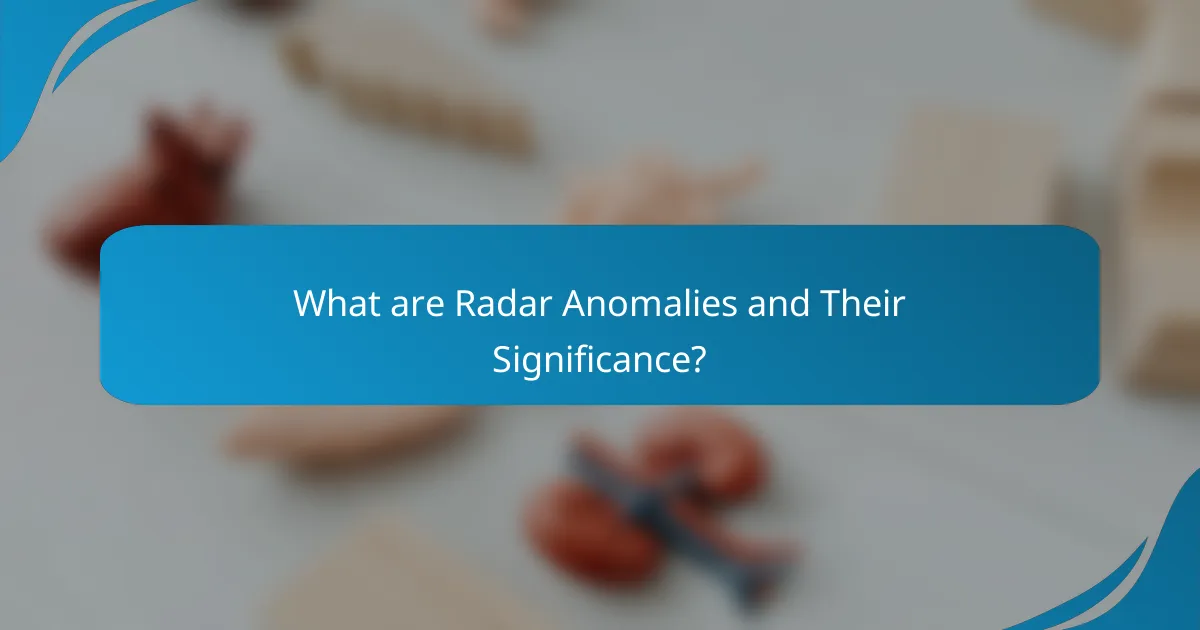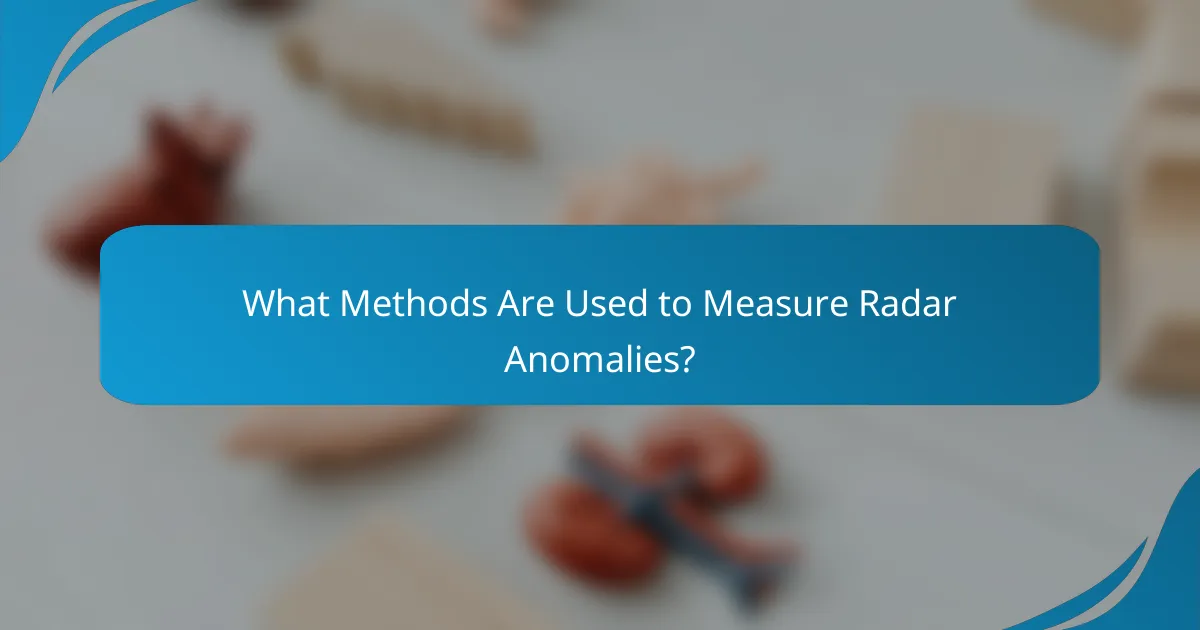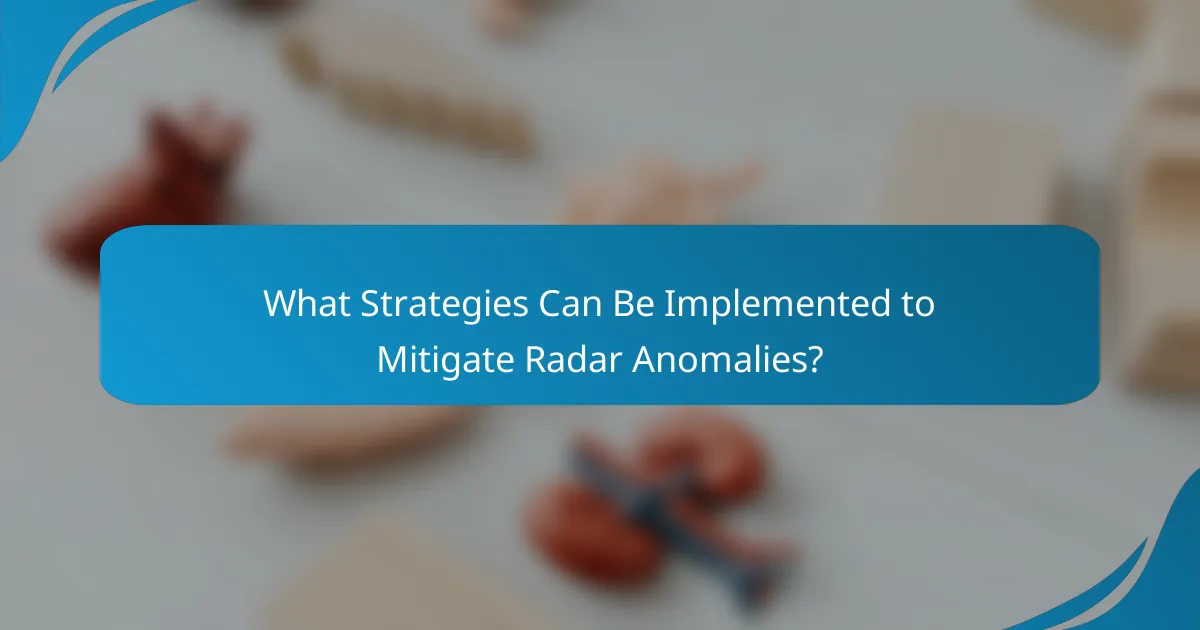Radar anomalies are unexpected variations in radar signals that can indicate the presence of objects or environmental conditions, significantly impacting radar system performance and accuracy. Factors such as weather, terrain, and signal interference contribute to these anomalies, which can lead to a decrease in radar effectiveness by up to 30%. This article explores the measurement techniques used to identify radar anomalies, including signal processing, radar cross-section analysis, and Doppler processing. It also discusses strategies for mitigating these anomalies through regular calibration, advanced signal processing, environmental monitoring, adaptive systems, and personnel training, all aimed at enhancing the reliability of radar operations.

What are Radar Anomalies and Their Significance?
Radar anomalies are unexpected variations in radar signals that can indicate the presence of objects or environmental conditions. These anomalies can result from factors such as weather, terrain, and interference from other signals. Their significance lies in their ability to affect radar system performance and accuracy. For instance, precipitation can cause attenuation, while ground clutter can obscure targets. Understanding radar anomalies is crucial for improving detection capabilities. Research shows that environmental conditions can lead to a 30% decrease in radar effectiveness. Consequently, mitigating these anomalies is essential for reliable radar operations.
How do environmental factors contribute to radar anomalies?
Environmental factors significantly contribute to radar anomalies by affecting signal propagation and reflection. Weather conditions such as rain, snow, and fog can attenuate radar signals. Temperature inversions can create unexpected radar returns by bending signals. Terrain features, like mountains and buildings, can cause multipath reflections. Additionally, atmospheric conditions can introduce clutter, leading to false targets on radar displays. These effects are documented in various studies, confirming the correlation between environmental factors and radar performance. For instance, research indicates that heavy precipitation can reduce radar range by up to 50%.
What specific environmental conditions affect radar performance?
Radar performance is affected by several specific environmental conditions. These include precipitation, which can attenuate radar signals and reduce detection range. Atmospheric conditions such as humidity and temperature can also influence radar wave propagation. Fog and clouds can scatter radar signals, impacting clarity and accuracy. Terrain features, like mountains and buildings, may obstruct radar signals and create shadow zones. Additionally, electromagnetic interference from other devices can degrade radar performance. Each of these conditions can significantly alter radar effectiveness in detecting and tracking objects.
How do atmospheric phenomena influence radar readings?
Atmospheric phenomena significantly influence radar readings. Changes in temperature, humidity, and pressure can alter the propagation of radar signals. For instance, temperature inversions can cause radar waves to bend, leading to inaccurate distance measurements. Humidity affects the attenuation of radar signals, especially in precipitation. Additionally, phenomena like thunderstorms can create clutter on radar displays, masking actual targets. The presence of atmospheric conditions can also lead to false echoes, complicating data interpretation. Studies show that these influences can lead to misinterpretations in weather forecasting and aviation safety.
Why is understanding radar anomalies important for various industries?
Understanding radar anomalies is crucial for various industries because they can significantly affect operational safety and efficiency. In aviation, radar anomalies can lead to misinterpretation of aircraft positions, risking collisions. In maritime navigation, they may cause false targets, impacting safe passage. The automotive industry relies on radar for advanced driver-assistance systems. Anomalies can compromise vehicle safety features.
Additionally, in defense applications, radar anomalies can hinder threat detection and tracking. Industries must analyze these anomalies to improve system reliability and accuracy. Research shows that environmental factors like weather can exacerbate radar anomalies, emphasizing the need for continuous monitoring and adaptation. Understanding these complexities enables industries to implement effective mitigation strategies.
Which sectors rely heavily on accurate radar data?
The sectors that rely heavily on accurate radar data include aviation, maritime, military, and meteorology. Aviation uses radar for air traffic control and collision avoidance. Accurate radar data ensures safe navigation and efficient flight operations. Maritime sectors depend on radar for vessel tracking and navigation in crowded waters. Military applications utilize radar for surveillance and target acquisition. Meteorology relies on radar to track weather patterns and storm systems. These sectors demonstrate the critical importance of precise radar data for safety and operational efficiency.
How can radar anomalies impact safety and operations?
Radar anomalies can significantly impact safety and operations by causing misinterpretations of data. These anomalies may lead to false targets or missed detections. In aviation, this can result in incorrect altitude readings or collision alerts. Such errors can compromise flight safety and operational efficiency. For maritime operations, radar anomalies can obscure obstacles, increasing the risk of accidents. Studies show that up to 30% of radar errors can be attributed to environmental factors. Accurate radar readings are crucial for navigation and situational awareness. Thus, understanding and mitigating radar anomalies is essential for maintaining safety standards.

What Methods Are Used to Measure Radar Anomalies?
Radar anomalies are measured using various methods, including signal processing techniques, radar cross-section analysis, and Doppler processing. Signal processing techniques involve analyzing the returned radar signals to identify deviations from expected patterns. Radar cross-section analysis quantifies the reflected energy from targets, helping to detect anomalies. Doppler processing examines changes in frequency of the returned signal, indicating motion or unexpected objects. These methods are validated through empirical studies and real-world applications, demonstrating their effectiveness in identifying radar anomalies.
How is data collected for analyzing radar anomalies?
Data for analyzing radar anomalies is collected through various methods. These methods include ground-based radar systems, airborne radar platforms, and satellite-based radar technology. Ground-based systems capture data from specific locations and can provide high-resolution information. Airborne platforms allow for broader coverage and can collect data over different terrains. Satellite technology enables global monitoring and can detect anomalies from space.
Additionally, data collection involves using specialized software to process radar signals. This software analyzes the returned signals to identify anomalies. Environmental factors such as weather conditions, terrain, and atmospheric conditions are also monitored. These factors can significantly influence radar performance and anomaly detection. The integration of these data sources enhances the accuracy of anomaly analysis.
What technologies are utilized in radar anomaly detection?
Radar anomaly detection utilizes various technologies, including signal processing algorithms, machine learning, and artificial intelligence. Signal processing algorithms help filter and analyze radar data to identify unusual patterns. Machine learning models can be trained on historical data to recognize anomalies based on learned features. Artificial intelligence enhances decision-making by integrating various data sources and improving detection accuracy. Additionally, advanced radar systems employ techniques like Doppler processing and multi-static radar configurations to enhance anomaly detection capabilities. These technologies collectively improve the reliability and effectiveness of radar systems in detecting environmental influences and anomalies.
How do measurement techniques vary based on environmental conditions?
Measurement techniques vary significantly based on environmental conditions. Different conditions such as temperature, humidity, and atmospheric pressure affect the accuracy and reliability of measurements. For instance, radar measurements can be influenced by precipitation, which can attenuate signals. High humidity may lead to increased signal scattering, affecting data quality. Temperature variations can cause changes in the speed of sound, impacting acoustic measurements. Furthermore, electromagnetic interference from environmental sources can distort measurements. These factors necessitate the use of adaptive techniques to ensure precise data collection under varying environmental circumstances.
What challenges exist in measuring radar anomalies?
Measuring radar anomalies presents several challenges. One significant challenge is signal interference from environmental factors. Weather conditions, such as rain or snow, can distort radar signals. Another challenge is the complexity of distinguishing between actual anomalies and noise. This requires advanced algorithms and processing techniques. Additionally, radar systems often have limitations in resolution and accuracy. These limitations can hinder the detection of smaller anomalies. Calibration of radar equipment is also crucial and can be difficult. Inconsistent calibration can lead to erroneous measurements. Overall, these factors complicate the accurate measurement of radar anomalies.
How do environmental variations complicate radar measurements?
Environmental variations complicate radar measurements by affecting signal propagation and accuracy. Factors such as temperature, humidity, and precipitation can alter the radar signal’s path. For instance, increased humidity can lead to signal attenuation. Temperature inversions can create ducting effects, causing radar waves to travel further than expected. Additionally, precipitation can scatter radar signals, leading to erroneous readings. These variations can result in misinterpretations of objects or conditions being measured. Studies show that environmental conditions can introduce significant errors in radar data, impacting decision-making processes.
What are the limitations of current radar measurement technologies?
Current radar measurement technologies have several limitations. One major limitation is sensitivity to environmental factors. Rain, snow, and fog can significantly degrade radar signal quality. This results in reduced accuracy and reliability of measurements. Another limitation is the inability to penetrate certain materials. Radar cannot effectively measure through solid objects like buildings or mountains. Additionally, current technologies often struggle with detecting small or low-velocity targets. This can lead to missed detections in critical applications. Furthermore, radar systems may experience interference from other electronic devices. This can cause false readings and complicate data interpretation. Lastly, radar technologies typically have limitations in range resolution. This affects the ability to distinguish between closely spaced objects.

What Strategies Can Be Implemented to Mitigate Radar Anomalies?
Implementing strategies to mitigate radar anomalies involves several key approaches. First, regular calibration of radar systems ensures accurate performance. This process helps to reduce measurement errors caused by environmental changes. Second, utilizing advanced signal processing techniques enhances the ability to filter out noise. This can significantly improve the clarity of radar data. Third, environmental monitoring is crucial. Understanding atmospheric conditions can help predict and counteract anomalies. Fourth, utilizing adaptive radar systems allows for real-time adjustments based on detected anomalies. This flexibility can enhance overall system reliability. Lastly, conducting thorough training for personnel ensures effective response to anomalies. Training equips staff with skills to troubleshoot and resolve issues promptly. Each of these strategies contributes to a more robust radar operation.
How can environmental impacts on radar anomalies be minimized?
Environmental impacts on radar anomalies can be minimized by implementing advanced signal processing techniques. These techniques enhance the clarity of radar signals amidst environmental noise. Additionally, optimizing radar system design can reduce susceptibility to interference. Using adaptive filtering can also help in mitigating the effects of unwanted reflections. Regular calibration of radar equipment ensures accuracy in readings. Furthermore, selecting appropriate radar frequencies can minimize the influence of environmental factors. Employing shielding and protective measures around radar installations can reduce external disruptions. These strategies collectively improve radar performance in challenging environmental conditions.
What best practices exist for radar system calibration?
Regularly calibrate radar systems to ensure accurate measurements. Calibration should occur before deployment and periodically during operation. Utilize standardized calibration targets to verify system performance. Conduct environmental assessments to understand how factors like temperature and humidity affect readings. Maintain detailed records of calibration procedures and results for traceability. Use automated calibration tools to improve efficiency and reduce human error. Train personnel on calibration techniques to ensure consistency. Follow manufacturer guidelines and industry standards for calibration practices.
How can technology advancements improve radar reliability?
Technology advancements can improve radar reliability through enhanced signal processing algorithms. These algorithms reduce noise and filter out interference, resulting in clearer signals. Improved hardware, such as better antennas and transmitters, increases sensitivity and range. Advanced materials can also minimize environmental effects on radar performance. Machine learning techniques can adaptively optimize radar systems in real-time. For instance, adaptive beamforming can focus on desired signals while suppressing unwanted reflections. Additionally, integration with other sensors can provide complementary data, enhancing situational awareness. These advancements collectively lead to more accurate and dependable radar systems.
What role does training play in managing radar anomalies?
Training plays a crucial role in managing radar anomalies. It equips personnel with the skills needed to identify and interpret anomalies accurately. Effective training enhances the understanding of radar systems and their environmental interactions. Personnel learn to differentiate between genuine signals and false returns caused by anomalies. This knowledge is vital for making informed decisions during operations. Additionally, training includes simulations that replicate various anomaly scenarios. These exercises improve response times and operational readiness. Studies show that well-trained operators significantly reduce the risk of misinterpretation. Therefore, comprehensive training is essential for effective radar anomaly management.
How can operators be better prepared to handle radar anomalies?
Operators can be better prepared to handle radar anomalies by implementing comprehensive training programs. These programs should focus on identifying and diagnosing radar anomalies. Operators need to be familiar with common environmental factors that cause these anomalies. Regular drills can enhance their response time and decision-making skills during actual events. Access to updated technical manuals and anomaly response protocols is essential. Utilizing advanced radar systems with built-in anomaly detection capabilities can also aid operators. Continuous monitoring of environmental conditions will provide critical data for anticipating anomalies. Historical data analysis can help in recognizing patterns and improving preparedness.
What resources are available for ongoing education in radar technology?
Online courses from platforms like Coursera and edX offer ongoing education in radar technology. These courses cover fundamental and advanced topics. Universities also provide specialized radar technology programs. Institutions such as MIT and Stanford have relevant offerings. Professional organizations like IEEE provide webinars and certification programs. Additionally, industry conferences are valuable for networking and learning. Research journals publish the latest findings in radar technology. These resources ensure continuous learning and skill enhancement in the field.
What are the best practices for addressing radar anomalies in real-time?
The best practices for addressing radar anomalies in real-time include immediate identification and assessment of the anomaly’s nature. Operators should utilize advanced signal processing techniques to distinguish between true targets and false returns. Continuous monitoring of environmental conditions is essential, as factors like weather can significantly affect radar performance. Implementing automated alert systems can enhance response times to anomalies. Collaboration with meteorological services provides additional context for anomalies linked to environmental factors. Regular training for radar operators ensures they are equipped to interpret data accurately. Lastly, maintaining a comprehensive database of past anomalies aids in recognizing patterns and improving future responses.
The main entity of the article is radar anomalies, which are unexpected variations in radar signals influenced by environmental factors. The article examines how conditions such as weather, terrain, and atmospheric phenomena affect radar performance, potentially leading to significant operational challenges across various sectors, including aviation, maritime, and military. It discusses measurement techniques for detecting radar anomalies, the challenges posed by environmental variations, and strategies for mitigation, including advanced signal processing and regular system calibration. Additionally, it highlights the importance of training and technology advancements in improving radar reliability and operator preparedness.